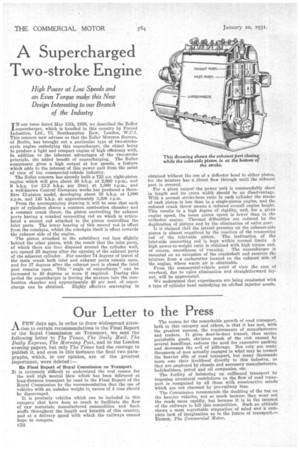A Supercharged Two-stroke Engine
Page 46

If you've noticed an error in this article please click here to report it so we can fix it.
High Power at Low Speeds and an Even Torque make this New Design Interesting to our Branch of the Industry
IN our issue dated May 13th, 1930, we described the Zoller Isupercharger, which is handled in this country by Forced Induction, Ltd., 73, Southampton Row, London, W.C.I. This concern now advises us that the Zoller Motoren Bureau, -of Berlin, has brought out a particular type of two-strokecycle engine embodying this supercharger, the object being to produce a light and compact engine of high efficiency with, in addition to the inherent advantages of the two-stroke principle, the added benefit of supercharging. The Zoller compressor gives a high output at low speeds, a feature which adds to the interest of this power unit from the point of view of the commercial-vehicle industry.
The Zoller concern has already built a 723 c.c. eight-piston engine which will give about 30 b.h.p. at 2,000 r.p.m., and b.h.p. (or 12.3 b.h.p. pep litre) at 1,000 r.p.m., and a well-known Central European works has produced a threelitre 12-piston model, developing about 38 b.b.p. at 1,000 r.p.m. and 145 b.h.p. at approximately 3,300 r.p.m.
From the accompanying drawing it will be seen that each pair of cylinders shares a common combustion chamber and a common crank throw, the piston controlling the exhaust ports having a cranked connecting rod on which is articulated a second rod attached to the piston controlling the inlet ports. The lower bearing of this second rod is offset from the crankpin, whilst the crankpin itself is offset towards the exhaust side of the engine.
The piston attached to the subsidiary rod lags slightly behind the other piston, with the result that the inlet ports, of which there are four disposed around the cylinder wall, are opened 28 degrees after the opening of the exhaust ports of the adjacent cylinder. For another 74 degrees of travel of the main crank both inlet and exhaust ports remain open, and for 37 degrees after the exhaust port is closed the inlet port remains open. This "angle of supercharge" can be increased to 40 degrees or more if required. During this period the supercharger is forcing the mixture into the combustion chamber and approximately 40 per cent, of super
charge can be obtained. Highly effective scavenging is
obtained without the use of a deflector head to either piston, for the mixture has -a direct flow through until the exhaust port is covered.
For a given output the power unit is commendably short in length and its extra width should be no disadvantage. With a normal stroke-bore ratio in each cylinder the stroke of each piston is less than in a single-piston engine, and the reduced crank throw means a reduced overall engine height. This results in a high degree of rigidity, and, for a given engine speed, the mean piston speed is lower than in the orthodox engine. Thermal difficulties are reduced by the duplication of pistons and by the elimination of valve gear.
It is claimed that the lateral pressure on the exhaust-side piston is almost negatived by the reaction of the connecting rod of the inlet-side piston. The inclination of the inlet-side connecting rod is kept within normal limits. A high power-to-weight ratio is obtained with high torque and, of course, smoothness of running. The supercharger is mounted on an extension of the crankshaft and receives the mixture from a carburetter located on the exhaust side of the engine, Where warm air is obtainable.
From the commercial-vehicle point of view the ease of overhaul, due to valve elimination and straightforward layout, will be appreciated.
We understand that experiments are being conducted with a type of cylinder head embodying an oil-fuel injector nozzle.












































































































